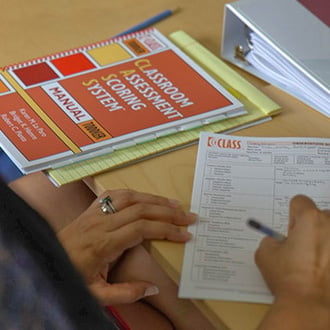
As a Teachstone trainer, I spend most weeks preparing early childhood educators to conduct CLASS observations or to train others to conduct CLASS observations. During our two- or three-day trainings, we cover a lot of material. I have to prepare my trainees to deeply know and understand the CLASS Manual, feel comfortable taking detailed notes while keeping an eye on what is happening in very complex classrooms, and of course, to take the dreaded reliability test.
No matter how hard I try, there’s a great deal of focus on the test. And I can’t blame anyone for this. Jobs depend on it, we all want to pass, and a test is a test is a test. But once you pass the test and are ready to begin your live observations, questions often arise that you may not have thought of before. Here are a few insider tips to get you ready and roaring to go on your first live CLASS observation:
- Talk to the teacher you are planning to observe and find out the schedule for the day. Depending on the policies in your organization, you may want to call the teacher ahead of time so you know what to expect and plan accordingly.
- Show your certification card. You worked hard for this card and you should display it proudly. It will help the teacher know that you are reliable and it will keep the field more accountable for ensuring fair and accurate observations.
- Determine what you’ll observe and what you won’t observe. Sometimes, a part of the class will go to music while the rest of the class will remain. Will you follow the children who go to the music lesson? A great way to determine what to do is to follow Tip #1 and talk to the teacher about the schedule for the day. If the music lesson will be just free play with instruments, you may want to stay put, but if the children will be learning a song to sing to the parents, there could be some good opportunities to code instruction during the lesson and you may choose to follow those children. Same for outdoor play; try to determine if the play will be structured or unstructured.
- Do observe during a meal time. Now this is a controversial one—especially when meals are in pre-K programs in school cafeterias, observations can result in lower scores. But this needs to be documented as part of the children’s day, and a very important one at that. Documenting the average experience of a child in the classroom (or at meals) is how we create change! And if you’re looking for some additional tips on coding during meal times, check out this post.
- Wear casual and subdued clothing and jewelry. Be uninteresting to the children so they go back to their activities instead of focusing on you. Bring only what you need. You’re going to need to move around the classroom to see and hear what is happening. Don’t confine yourself to a corner of the room because you have too much stuff, and don’t engage the children except to politely and concisely answer their questions.
- Plan ahead for what you’ll do if there are multiple teachers in the room. The CLASS Manual discusses this scenario on page 10. Remember that the goal is to code for the average experience of a child in the classroom. Usually you will be observing the lead teacher, or the teacher who is interacting with most of the children, but you should consider observing any teacher that is interacting with children at least for a short time.
- Reread your CLASS Manual. An observation is not the time to study your manual; it’s the time to be able to navigate quickly and reference the material you need most. The goal is to take around 10 minutes to assign scores, so you’ll need to be comfortable finding what you need and navigating CLASS language.
- Calibrate. If it’s been a while since you certified, you may want to consider calibrating. You’ll view and code a classroom video and receive immediate feedback on your scoring—all online. Also consider “double-coding with another certified observer. Observe the same things, code independently, then share what you saw and how you came up with that code. It will help you both to revisit the CLASS lens.
- Know your weaknesses. After training and testing, you know the dimensions you struggle with most. Maybe you over-code Concept Development or under-code Productivity. Review exemplars in the Video Library in the dimensions that are most difficult for you so you know exactly what a high level score looks like in that dimension.
- If you’re a myTeachstone user and plan to use the myTeachstone app to conduct your observation, make sure you have logged into the system before and have taken the time to explore the technology. Using the app will make your life so much easier (goodbye messy paperwork, hello fast typing and simple data submission), but you need to feel comfortable navigating the technology before you arrive in the classroom. Curious about the app? Learn more about it and myTeachstone here.
I hope these tips are helpful and that you’ll share any you might have below. Happy coding!

